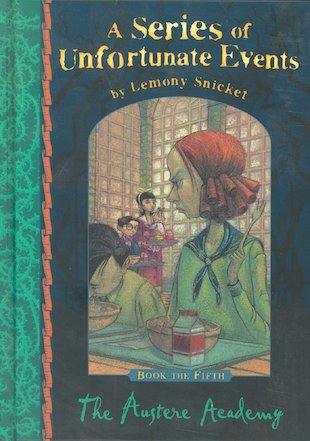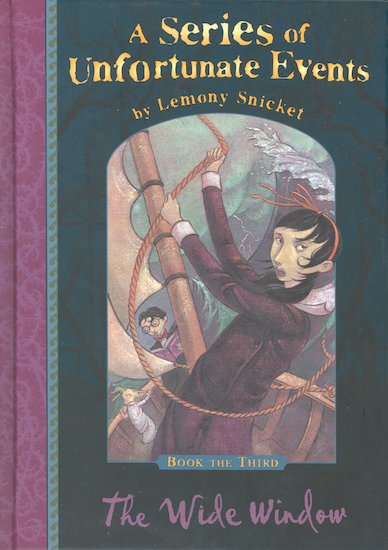
Book 4
Hey readers,
So today here is part two of my A Series of Unfortunate Events Review. I'll be looking at the next three books, that's books 4, 5 and 6. So here goes! Book 4's title The Miserable Mill really fits in with the book's setting as the Baudelaires are sent to live and work in Lucky Smells Lumbermill. Their new guardian being the owner, Sir, always has his head covered by a cloud of smoke. So no one really knows his name or face. Olaf makes his appearance as Shirley, a female receptionist, who works for Dr Orwell, an optometrist. (That's someone who takes care of and treats the eyes)
The plot is that Klaus has his glasses broken and has to go to Dr Orwell. When he returns he is different and Violet and Sunny don't understand it. Klaus's glasses get broken again and this time they all go to see Dr Orwell. They also discover Olaf in his disguise. Violet works out that Klaus is being hypnotized and that Orwell and Olaf are working together. Violet then reads up about hypnotizes, but is interrupted by wood being cut. She and Sunny run in and find Klaus using a buzz saw on Sir's business partner. Using the book, they are able to get Klaus out of the hypnotizes, but only after a fight with the foreman, Olaf and Orwell. Sir and Poe show up and the Baudelaires explain what has happened, however Olaf escapes.
The fourth book to me was the turn in the series. You start to realize that there is more to the Baudelaires and their guardians' backgrounds. Also sub-plot threads start to appear and if you don't pick up on the patterns in the first three books then they should be clear by this one. You get further development of the characters as well in the form of them trying to think like each other and use each others' special skill. This is something that appears often in the series.
There is a lesser connection with the guardian compared to the first three in this book. The orphans don't spend a lot of time with Sir, as they are made to work and live with the other workers. This just adds far to the mystery of the Sir character. It also shows that the orphans are growing up as they are more able to look after themselves and each other then before.
One of the main themes of the series, which appears in all the novels, is libraries and books. This also ties in with another theme; literature, which Snicket uses to make outside references to literary figures. (see part 1). Libraries and books appear not only due to Klaus needing for them for his research, but for other characters to do so as well. A love of books can be picked up strongly and there is the idea that almost anything that is needed can be find within the pages of books. Another thing to come out of this is the familiarity and comfort that the Baudelaires get out of libraries and books. Many people can easily relate to this.

Book 5
The Austere Academy, really continues the turning point and we also see the Baudelaires at school for the first time. This makes you wonder why they haven't been going before, but I guess they've been too busy being moved about and chased by Olaf to actually get settled in a school. The plot for this one is longer and a bit more complex, which then follows on for the rest of the series. It is interesting to see how Snicket has developed the series and I'd so recommend any writer looking to write their own series to read this one. It really want take you very long either.
The plot; the Baudelaires has been sent to Prufrock Prep School and their new guardian is Nero, the Vice Principal. He explains how the school works and that they have an advance computer which will keep Olaf away- as if!- However, because they are orphans they won't be allowed to stay in the dorm rooms, but have to live in a tin shack in the grounds of the school. They meet Carmelita Spats, a student at the school, who takes a disliking to them as they are orphans. She is also very rude and the readers a drawn to disliking her.
To balance this out, the Baudelaires meet and become friends with the Quagmires; Duncan and Isadora, who are actually triplets, but their brother Quigley died alongside their parents in a fire. Duncan wants to be a journalist and Isadora a poet. The Baudelaires start their classes but soon discover that their teachers are pretty useless and the lessons are not as they should be. Sunny, being to young to actually go to school is made into Nero's admin assistant. She is given tasks to do that would be impossible for a toddler, but some how she gets through and her siblings help her.
Olaf then appears as Coach Genghis and when the Baudelaires try to tell Nero, Olaf appears and eludes them. They then have to meet him to do special orphan running exercises at night. They basically run around a large circle for no real reason. Though this does become clear as they are too tried for their tests and Sunny's office work suffers. Nero tells them that they'll have to be tutored by Genghis if they continue to fail. They go to see the Quagmires and come up with a plan, which does work well. The Baudelaires are then tested and pass. Genghis then arrives and discovers the first part of the plan- which was for the Quagmires and a bag of flour to take the Baudelaires' places on the running track. The Baudelaires try to reveal Olaf as Poe shows up and is told by Nero that the orphans are being expelled for cheating. Olaf is discovered and runs away, kidnapping the Quagmires and their notebooks, which contain information on V.F.D, that the Baudelaires need to become aware of. However, Poe then moves on then onto their new guardian and the Baudelaires have to prepare for more misfortune.
New characters and plot threads appear in the here. Some of the information gained becomes important in the next few books. It's also about time the Baudelaires make some friends their age too, even though the Quagmires seem to be stuck in a similar situation. They do appear throughout the next few books though and they are key to the Baudelaires learning more about V.F.D and their parents. I really like how each book reveals just a little bit of the wider picture. You also get really hooked to want to keep reading to find out more.

Book 6
This is possible my second favorite book in the series. Though I do like number 5, I really can't stand Carmelita- as you are meant too! What I like about the Ersatz Elevator is that the Baudelaires get lured into a false sense of security and the twist at the end is really good. You also start to wonder if the Baudelaires had actually found themselves with a good guardian in the beginning, how would their lives be? I guess the complete opposite way around. They also wouldn't develop into the interesting characters that they are.
The plot; arriving at their new home; 667 Dark Avenue, the Baudelaires meet Jerome and Esme Squalor. Esme is an financial adviser and very into things that are 'in' and 'out. We're not just talking about fashion here but everything! The reason why the streetlights and elevator don't work is because they are out and the only reason the children are there is because orphans are in. They learn about that a little later. At first nothing seems wrong with their new guardians and they settle in. However, Olaf shows up dressed as an auctioneer called Gunther. Esme is meeting him to discuss the up and coming in auction. They try to point out who he is, but Jerome takes them out for dinner.
They then noticed the fake elevator and on climbing down find the Quagmires in a cage. Returning, they work on a plan and make tools to get their friends out. As they go down the shaft again, they see that Olaf has already taken them. Going to back to the penthouse again, they try to figure out Olaf's plan. the Quagmires managed to tell them that Olaf was going to hide them in one of the in auctions lots. Klaus suggests the lot might be number 50 - VFD after viewing it in the booklet. They go to tell Esme and discover that she is working with Olaf, she pushes them down the fake elevator shaft. Lucky, they land in a net and Sunny-using her teeth-is able to climb up the shaft and get the rope they made to save the Quagmires. Returning, they get out of the net and climb further down the shaft. At the bottom they find a passageway which ends in a trap door, leading to the burnt out Baudelaire Mansion.
Having little time to wonder why this is, they run to the auction and ask Jerome to buy them lot 50. He bids off against Poe, but Sunny wins in the end. They then see that the lot is a box full of doilies and the Quagmires were hidden in something else. Olaf slips on a dollies, losing his disguise. He, Esme and his handyman escape. They then go back to the penthouse and Jerome wants to take the children far away so that he can keep them safe. However, they don't want to go as they need to help the Quagmires. Knowing he can't help, Jerome gives them up and Poe has to move them on again.
The braver of the character stands out in this story, because I can't imagine having to climb down or up an elevator shaft. Maybe its the unusual and slight impossible feel the plot creates that draws me to like this one a lot more. I also like the addition of the Quagmires because we are able to learn a lot about them and that doesn't happen with most of the other characters. The slight problem with them is that sometimes their back story feels to close to the Baudelaires' story. The deeper connection between them does come across further in the series and we do get to see why their backgrounds are similar. Something to look at next time.
Images from:
http://www.dooyoo.co.uk/junior-book/a-series-of-unfortunate-events-no-6-the-ersatz-elevator-lemony-snicket/
Additional Information;
http://en.wikipedia.org/wiki/The_Ersatz_Elevator
Additional Information;
http://en.wikipedia.org/wiki/The_Ersatz_Elevator




